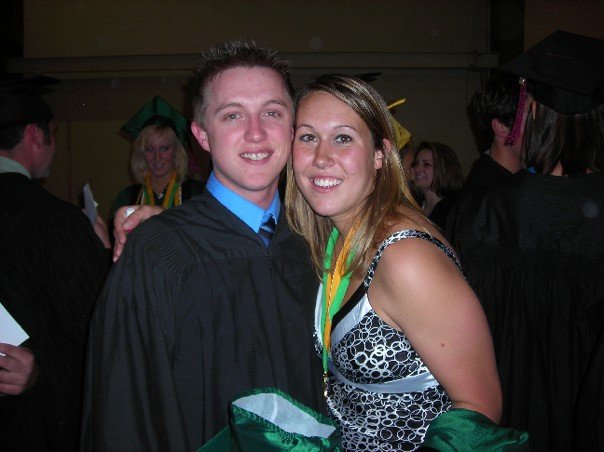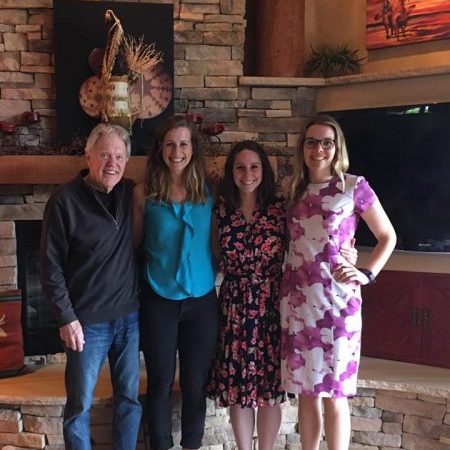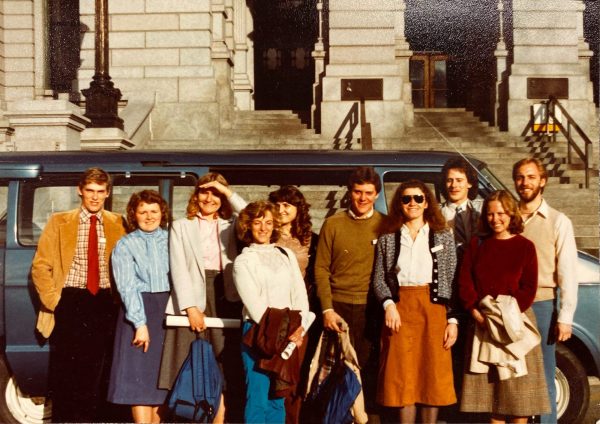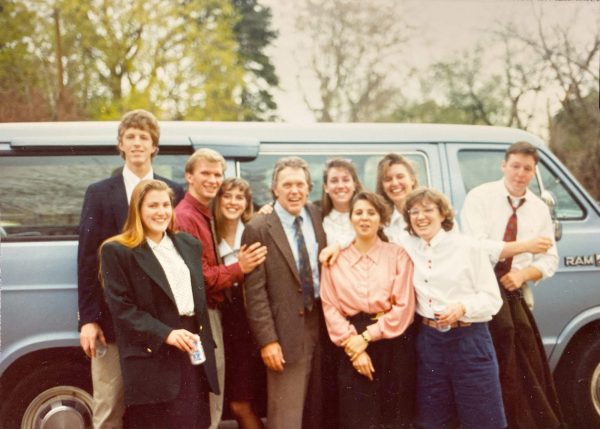It’s a cold, crisp, dark morning. It’s so early that the sun isn’t even up yet, and won’t be for another half hour. Everyone is a little bleary-eyed and the chatter is minimal. The smell of coffee permeates the vehicles, but still, no one is quite ready to be there. Headphones go on and eyes close.
It’s mostly silent as the two, 12-passenger vans head south on Interstate 25, morning light slowly streaming in the sleepy windows as the sun peaks up over the eastern plains.
When the vans reach northern Denver things start to liven up. The coffee slowly takes effect. Some students are on the State Capitol Facebook page, trying to get a sense of which organizations will be there today and which of those organizations might be serving a free breakfast.
Getting off of 1-25 in downtown Denver is when things really get lively.
Avoid the right lane…cars are turning into the parking garage.
Avoid this next lane, or an RTD bus will cut us off.
Time the lights right and we’ll be able to sail through for several blocks.
There’s the Brown Palace…cut in now and get into the far left lane.
Was that a curb check? That was definitely a curb check.
Cars on 14th Street are turning left and stopping traffic… cut into the outside lane, cut back and there we are, first van to the Capitol.
After 40 plus years of teaching the Political Science Legislative Internship class, Professor Emeritus John Straayer knew exactly how to drive his van through downtown Denver to ensure that he got to the capitol building before the other van, even if he started out behind in the HOV lane on I-25.
“I almost always won,” Straayer said.
To be fair, the opposing van’s driver, an undergraduate student, always lacked Straayer’s years of practice bobbing and weaving through Denver’s legendary traffic.
Though the legislative internship program began in 1974, Straayer took over in 1980, driving one of two 12-passenger vans to the state capital every Tuesday and Thursday of every spring semester until 2017, when he handed the internship over to Dr. Bob Duffy. More than 1,100 students have gone through the internship program, each student getting the unique opportunity to work directly with a legislator or lobbyist.
With the internship program came a minimum of four hours a week and 588 hours a semester, when the legislative interns shared a small, cramped van space.
From cohort to cohort, most morning van rides to Denver were quiet and sleepy, but the van rides home were a different story. Sometimes the talk was simple: where everyone went to lunch that day, weekend plans, what kind of music they would play in the vans, etc., but for many students, the van was where learning happened; learning that couldn’t be taught in a classroom, or even through the internship itself. With so much in common and so much van time together, it’s no surprise that many interns left the experience with new lifelong friends.
Always returning home
Aly Schmidt (intern 2010) remembers that the year she interned, the class was split fairly evenly between Democrats and Republicans.
“We had big debates on our way home, not only about policy issues but about any drama that happened on the floor that day,” Schmidt said. “Because it was an election year, we were always debating about who was good and who wasn’t.”
Schmidt now works as a contract lobbyist for Headwaters Strategies. She and three previous interns from different cohorts come back to CSU every fall semester and talk to the students of the Legislative Politics class, the prerequisite to the Legislative Internship, about what it’s like to be a lobbyist and their experiences as interns.

The power of peers
For Luke Ragland (intern 2007), a connection he made in the van that year was quite significant; he met his wife, Sarah.
“She would probably tell you I was the loud, obnoxious one in the van, always trying to crack jokes,” Ragland said. Even though the couple interned for legislators on opposite sides of the aisle, their love for boisterous, bi-partisan debates ultimately brought them together.
“I’m not sure we would have gotten to know each other if it hadn’t been for the van,” Ragland said. Now, the couple has been married for seven years and have a child, with another one on the way.
The time in the vans not only benefitted Ragland personally, but also professionally. Ragland now runs his own political advocacy organization, Ready Colorado, and credits several of the interns in his cohort for helping him get his business off the ground.
“People underestimate the power of networking among peers, and the van truly became a place to share stories, commiserate, and network,” Ragland said.

From the State Capitol to the Nation’s Capitol
Finding a student to volunteer to drive one of the two vans has always been a struggle for Straayer and Duffy. When Jess Dyrdahl (intern 2007) was sitting in her Legislative Politics class and Straayer asked who wanted to be one of the student drivers for the internship, her hand went up immediately.
Jess was one of two student drivers during Spring 2007, and she always drove on Tuesdays. Even though she had to be on campus earlier than the other students to get her van out of the CSU motor pool, she didn’t mind. Dyrdahl always made a point to make the van rides fun for everyone and loved playing music.
“I heard from some fellow students that my van was the most fun,” she said.

As the semester went on, a fellow intern, Ryan Strandland, became her co-pilot/van D.J. and then one of her best friends.
“We probably had some classes together prior to the internship but it was the van rides where we connected and became friends.”
After graduation, Dyrdahl went to work for CSU Admissions and Strandland got a job in Washington D.C. Luckily, one of Drydahl’s recruiting territories was D.C., which meant that she and Strandland met up with each other almost every time she was out there. Now that Drydahl works for the Student Leadership and Community Engagement Office at CSU and no longer travels to D.C., the two still get together when Strandland comes back to Colorado to see his family.
Looking back on her time as intern and van pilot, Dyrdahl said, “To me it was a time to share stories, make connections, and engage with one another outside of classes and outside our respective offices.”
Friends for life
When Liz Bruns stepped into the van on the first day of the Spring 2015 internship, intimidation took a strong hold over any feeling of sleepiness that may have existed. When it comes to internship placement, priority is always given to graduating seniors and then juniors with excellent records. As one of the only juniors in the cohort, Liz didn’t know anyone.
“I remember being really intimidated that first morning by these professional, intelligent seniors who had it all together!” said Bruns.
Bruns’ nervousness quickly wore off when she sat next to senior Iris Hentze, who was really welcoming to Bruns. Hentze was also friends with Megan Bence, and with one van ride to Denver, these three interns were instant friends.
“We made sure we were always in the van together and would scheme before leaving the Capitol,” said Bence. “I think people started to catch on to us, too, because the other interns would see which van we would start to hover around and let us in first. We refused to be separated from each other on those van rides because it was one of the best parts of the day.”
Some days the three friends wanted to decompress and be in the van with the loud music, but a lot of times they schemed to get into Straayer’s van to pick his brain about different policies, and hear his stories from his years at the capitol.
“The political discussions we had in the vans and the fact that we never separated out by party affiliation were crucial experiences for me in how I think about public policy and bi-partisanship,” said Hentze. “The hours we had to discuss different issues, whether they be some deeply held belief, something related to legislation up in committee that day, or something we heard about walking the halls of the capitol, helped give me this deep understanding of why people believe what they believe, both those that are similar to me in ideology and those that couldn’t be more different.”

Since graduating from CSU the three friends are now in different parts of the world (California, Denver, Denmark), but they don’t let a few miles get in between their friendship.
Once a month the three friends get together via FaceTime. A topic of discussion is always where their next get-together will be.
Over the years, they have met up in Denver, Minneapolis, and San Jose, and they’re headed to Denmark for Liz’s wedding next summer.
“I wouldn’t have these friendships if I didn’t participate in the internship, and I think about that all the time,” said Bence.
Marriages, close friendships, and professional connections all formed over hot coffee and bad traffic in those CSU motor pool vans. Graduates of the internship fondly remember the professor who first created that space for them.
Hentze said, “He chose to surround himself with college students for at least 10 hours a day, twice a week, every spring semester, for dozens of years. In doing so, he gave us a truly unique opportunity that I think is very rare for college students, and I will forever be grateful for the chance I got to start my career in policy and make lifelong friends!”
As Straayer himself has been known to say so many times, “It’s a wonderful life…I drive a bus.”



